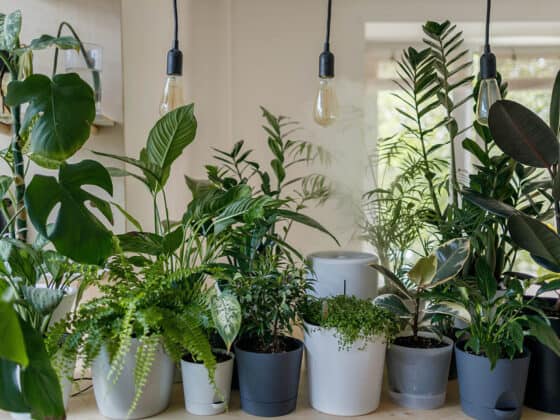Mealybugs are, by far, one of the strangest looking pests you might find on your houseplants. These fluffy little bugs appear as if from nowhere and can quickly cover your plant in white, cottony fuzz. They can also do a real number on its health! What exactly are these things, and what’s the best way to deal with them?
Mealybugs are little, sap-feeding insects that are often found tucked away among stem tips, along leave junctions, or covering new growth. They are easily identified by a cotton-like fuzz that covers their bodies and egg clusters. Although persistent pests, they are susceptible to many different treatments.
The damage mealybugs can inflict on a houseplant is significant, so it is best to act quickly when you realize you are dealing with an infestation. A thorough understanding of these bugs and how they operate can help you identify a mealybug issue early so the correct treatment can be applied before any real damage is done to your plant.
In this article, we’ll cover the most common questions regarding mealybugs to equip you with the knowledge necessary to eradicate them from your home effectively. Interested in a deeper dive into specific treatment options?
What Are Mealybugs?
Mealybugs are a small type of sap-sucking insect fairly recognizable due to the cotton-like coating surrounding their body. Although they are actually closely related to scale, mealybugs create this waxy coating instead of developing a harder shell. They also retain their legs, making them much more mobile.

Adult mealybugs are about 1/16” long and sport a pink, somewhat oval-shaped body. They can appear to be much bigger due to their cotton “fluff.” This is actually a waxy, filament-like coating that helps protect the insect from predators and extreme heat. Although there are several different species of mealybugs, the most common variety found on houseplant foliage is the citrus mealybug.

How Does a Houseplant Get Mealybugs?
Houseplants tend to be sheltered from many common pests that easily infest outdoor plants. It’s the luck of living indoors. However, mealybugs can still make their way into your home just by hitching a short ride from outside.
Because of their structure and size, mealybugs can easily attach to clothing, shoes, or passing pets. They often go unnoticed on outdoor plants, so as we carry on in the garden and head inside, we may inadvertently be harboring a number of unwanted hitchhikers on our sleeves that might make their way to a beloved houseplant.
Less commonly, but still possible, is that mealybugs will actually crawl right into our homes. Although it seems like an impossible journey, if you leave windows or doors open, these mobile insects might actually walk in and find a new home in a nearby houseplant. Also, because they are so small, they can be carried in on a strong breeze.
Most commonly, however, mealybugs are often introduced to your home when you bring a new plant inside. Plant stores and nurseries are pretty good at identifying pest issues, but it’s also plausible that a few lone mealybugs can hide away in a plant, undetected until it is bought and brought home.
It’s always a good idea to isolate any new plant purchases for a few days so you can monitor it for pests or diseases. Once you’re sure it looks happy and healthy, you can incorporate it with your other houseplants without worry.
Can Mealybugs Live Without Plants?
Many mealybugs live exclusively on plant foliage, using it as shelter, a breeding ground, and, most importantly, their food source. To successfully carry out their full life cycle, mealybugs need a plant to live on.
That being said, these insects can survive about two to three weeks without a plant. They are mobile and occasionally need to go out searching for a new host plant, so they are equipped to handle several days to a few weeks without the safety and sustenance that a plant provides. Obviously, if they are separated from a plant for too long, they will eventually perish, but even these little bugs can cover a lot of ground in search of a fresh houseplant in that time.
What Does Mealybug Damage Look Like?
Like many other common houseplant pests, mealybugs are sap-sucking insects, which means they chew through plant tissue to access the phloem, where the sugary sap transports nutrients throughout the plant. Although these bugs are pretty small, as their population grows, the damage they cause can add up quickly, putting your houseplant in a distressed state.
Some common symptoms of mealybugs damage include yellowing or chlorotic-looking leaves, dropping leaves, an overall wilted appearance, or stem and leave droop. In really severe cases, you might start to see new growth coming in that’s stunted or deformed.
Another really common indicator that you are dealing with a heavy mealybug infestation is the appearance of honeydew. Like aphids, mealybugs excrete this residue as a byproduct of sap feeding. This sticky substance begins to cover plant structures where bugs are present and can actually promote the growth of sooty mold all over the plant.
Overall, damage to the plant looks very similar to that of aphids or thrips, but it should be pretty clear what is causing the issues, as you’ll likely see the cottony bodies of mealybugs covering the plant by this point.
Can Mealybugs Move From Plant to Plant?
Of all the different pests found on your houseplants, mealybugs are some of the more sedentary ones. Although they do have the ability to crawl and are equipped to move from plant to plant, the good news is that they tend to stay pretty close to home. Females stay busy laying eggs and feeding, while the male’s only job is to reproduce. Male mealybugs develop wings and can fly great distances, but they are mainly concerned with finding a mate.
In reality, mealybugs only really spread from plant to plant when we give them the opportunity. To infest a new plant, female mealybugs either need to be transferred via clothing or pets, or the new plant needs to be in close proximity to the infested one so they can crawl to it. This is good knowledge to have because you can take immediate action by either quarantining a plant or giving your plants more space when you realize you are dealing with a pest problem. This will help contain any spread.
Can Mealybugs Kill Houseplants?
Initially, mealybug damage can be dismissed as pretty mild. When acted upon quickly, a plant suffering an infestation will usually bounce back once you treat it for mealybugs. However, when an infestation grows out of control, the damage these pests can inflict begin to compound and your plant is put under a tremendous amount of stress.
The physical damage from feeding begins to disrupt water and nutrient transport, and damaged leaf tissues become less efficient at carrying out important processes like respiration and photosynthesis. Eventually, the plant will succumb to the damage and may die, either from the damage itself and the disruption to its growth or from viral or fungal conditions that its weakened immune response can no longer fight against.
Are Mealybugs Harmful to Humans?
While mealybugs can do quite a bit of damage to a houseplant, they are harmless to humans. Their mouthparts are too small to bite through our thick skin, and they do not spread diseases to people. They are strange little bugs that can gross us out, but that’s about all the power they have over us.
Will Mealybugs Go Away on Their Own?
When left to their own devices, mealybugs will exponentially grow their population on an infested plant. One female can lay several hundred eggs, and without any interference on your part, you’re likely to see a population explode over the course of several weeks. These pests are only interested in feeding and reproducing; as long as their host plant produces sap and provides shelter, mealybugs are happy to stay where they are.
As feeding damage begins to compound, your houseplant will begin to suffer and eventually die. If the mealybug population doesn’t have another plant to move to, they will also perish over the next couple of weeks. This entire process may take several weeks or months.
By not treating an infestation as soon as you discover it, you’re allowing plenty of opportunities for female mealybugs to crawl out in search of a new houseplant to live and feed on. It is always best to quickly quarantine an infested plant and begin treatment as soon as possible to minimize the spread of mealybugs on your houseplants.
Can You Drown Mealybugs in Water?
As you discover a mealybug infestation and start looking into potential treatment options, you might be wondering if you can quickly nip the issue in the bud by submerging your houseplant in water to drown the insects. Although killing off mealybugs by drowning them is possible, I do not recommend this as a viable treatment method.
First of all, many insects can survive underwater for several hours to days, making it unlikely that a quick dunk will solve all your pest problems. Second, submerging an entire houseplant underwater will likely do more damage to the plant than the pests, putting it under even more stress than it already is.
Rather than submerging your plant, try using strong streams of water to blast mealybugs off the plant. This can quickly reduce the population to a more manageable number, making treatment efforts easier and more effective.
What Temperature Kills Mealybugs?
Like many insects, mealybugs have an optimal temperature range in which they thrive. Egg production increases, time to hatch decreases, and activity levels are maximized. For mealybugs, this happens at temperatures between about 75° F and 90° F. They can live well outside that range, but that is where they are most prolific. Because of this, many people wonder if exposure to temperatures outside of this optimal range can help control mealybug outbreaks.
While some research has been done that prolonged exposure to near freezing temperatures can kill mealybugs, I do not recommend trying this with your houseplants. These studies were done using outdoor shrubs and plants that are hardy enough to withstand colder conditions.
The extreme hot or cold temperatures you’d need to kill off a mealybug population are well outside the range in which most tropical houseplants can survive, so you’d likely kill your plant well before any mealybugs die.
How Do You Treat for Mealybugs?
Once you discover a mealybug infestation, it is a good idea to act quickly. You have a lot of different options available to treat for these pests, but first and foremost, you want to make sure you contain the spread.
Move your plant away from the rest of your houseplant collection, or quarantine it completely. Do a quick examination of the plant, noting signs of damage, its overall health, and ensure it has been properly watered. You want to keep your plant strong while you deal with the pests.
Rinsing your plant with a strong stream of water can dislodge a lot of mealybugs, knocking back the population to a more reasonable size. Only do this if your plant is hearty enough. Washing delicate plants can cause more damage.
At this point, you should consider your treatment options. Physical removal of the remaining mealybugs is a labor-intensive yet effective method for controlling the population. Subsequent water sprays, wiping with a damp cloth, or physically picking off individual insects works well, but be prepared to repeat these methods often, as new bugs will hatch, and some will always be hidden.
There are a variety of different sprays or coverage treatments that are also available. Alcohol sprays, insecticidal soaps, Neem oil, and diatomaceous earth all have different methods of covering and killing mealybugs. Most are very low-impact and non-toxic, making them safe to use in your home.
The key to these methods is all about consistency in coverage and repeat treatments. Mealybugs are good at hiding in all the different crevices of a plant, so be methodical in how you apply these sprays to ensure complete coverage. After a few days, you’ll likely want to repeat treatment to catch any insects you missed last time.
You can find a more in-depth description of several mealybug treatment methods.
Final Thoughts
After reading through these commonly asked questions, we hope you better understand what mealybugs are and how to identify and treat any potential infestations. They are sometimes stubborn bugs to get rid of, but a keen eye, quick action, and a consistent treatment schedule are all you really need to eradicate these pests from your home and keep your houseplants looking healthy and vibrant.















